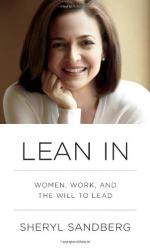
|
| Name: _________________________ | Period: ___________________ |
This test consists of 5 short answer questions, 10 short essay questions, and 1 (of 3) essay topics.
Short Answer Questions
1. Who is the former secretary of state that is cited in Chapter 11: “Working Together Toward Equality” for having said, “There’s a special place in hell for women who don’t help other women”?
2. In what year was Sheryl Sandberg named the Treasury Department’s chief of staff?
3. What U.C. Hastings law professor is cited in Chapter 11: “Working Together Toward Equality” for having said, “These mommy wars are so bitter because both groups’ identities are at stake because of another clash of social ideals: The ideal worker is defined as someone always available for work, and the ‘good mother’ is defined as always available to her children”?
4. What author does Sandberg quote in Chapter 10: “Let’s Start Talking About It” as having said, “Whoever has power takes over the noun—and the norm—while the less powerful get an adjective”?
5. In a 2007 study of well-educated professional women who had left the paid workforce, what percentage cited their husbands as a critical factor in their decision, according to the author in Chapter 8: “Make Your Partner a Real Partner”?
Short Essay Questions
1. Who is credited as approaching the gender gap well in his business dealings in Chapter 10: “Let’s Start Talking About It”?
2. What lesson does the author say she learned from her correspondence with Ray Kelly in Chapter 6: “Seek and Speak Your Truth”?
3. Who does the author praise for embracing emotion in the workplace in Chapter 6: “Seek and Speak Your Truth”?
4. What does the author write of Nora Ephron in Chapter 9: “The Myth of Doing It All”?
5. Who is one example that is cited by the author as an individual who had to make an immediate choice between career and family in Chapter 7: “Don’t Leave Before You Leave”?
6. What is one example of the dangers of blindly following leaders that Sandberg describes in Chapter 6: “Seek and Speak Your Truth”?
7. What barriers does the author discuss in the beginning of Chapter 6: “Seek and Speak Your Truth”?
8. What positive statistics does the author cite for women’s mentorship of women in Chapter 11: “Working Together Toward Equality”?
9. How does the author describe Dr. Laurie Glimcher’s approach to balancing career and family in Chapter 9: “The Myth of Doing It All”?
10. What does Sandberg describe as an ideal partner for women to succeed alongside in Chapter 8: “Make Your Partner a Real Partner”?
Essay Topics
Write an essay for ONE of the following topics:
Essay Topic 1
Examine and discuss the “double bind” that women face in regards to likeability and success in the workplace. How should women navigate the balance between owning one’s success and maintaining humility? What are practical suggestions given by the author in maintaining this balance?
Essay Topic 2
When Eric Schmidt suggested “fast growth” as the only important criterion for taking employment, what did he mean? Was he correct in this assessment? Do you think that this piece of advice is more valuable today, given the speed of technological advancement, than it was 50 years ago? Why or why not?
Essay Topic 3
Discuss some of the different stereotypes that apply to women and their impact on the female ego, propensity for achievement, and confidence. What negative stereotypes are frequently reinforced in our contemporary society? How are these stereotypes reinforced? What is “stereotype threat”?
|
This section contains 997 words (approx. 4 pages at 300 words per page) |

|




